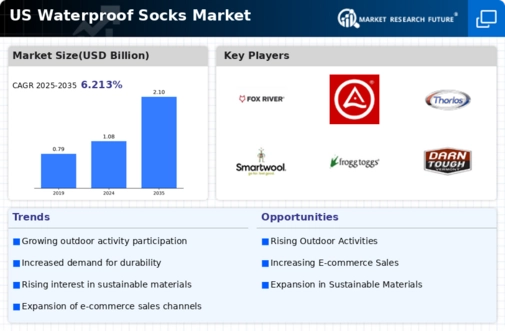Growth of E-commerce Platforms
The waterproof socks market is transforming due to the rapid growth of e-commerce platforms. As consumers increasingly turn to online shopping for convenience and variety, the accessibility of waterproof socks expands significantly. E-commerce sales in the outdoor gear segment have seen a remarkable increase, with estimates suggesting a growth rate of 15% annually. This shift allows consumers to explore a wider range of products, compare prices, and read reviews, ultimately influencing their purchasing decisions. Retailers are capitalizing on this trend by enhancing their online presence and offering exclusive deals, which may lead to increased sales in the waterproof socks market. The convenience of online shopping is likely to continue driving consumer interest and expanding market reach.
Rising Demand for Outdoor Gear
The waterproof socks market is experiencing a notable surge in demand as outdoor activities gain popularity among consumers. With an increasing number of individuals engaging in hiking, camping, and other recreational pursuits, the need for specialized gear, including waterproof socks, becomes apparent. According to recent data, the outdoor recreation industry in the US generates approximately $887 billion annually, indicating a robust market for related products. This trend suggests that consumers are willing to invest in high-quality gear that enhances outdoor experiences, thereby driving growth in the waterproof socks market. As outdoor enthusiasts prioritize comfort and protection from the elements, manufacturers are likely to innovate and expand their offerings, further stimulating market expansion.
Technological Innovations in Fabric
The waterproof socks market is influenced by advancements in fabric technology. Innovations in materials such as breathable membranes and moisture-wicking fabrics enhance the performance of waterproof socks, making them more appealing to consumers. For instance, the introduction of lightweight and durable materials has led to an increase in the functionality and comfort of these products. Market data suggests that the technical textile segment is projected to grow at a CAGR of 5.2% over the next five years, indicating a favorable environment for the waterproof socks market. As manufacturers continue to invest in research and development, the introduction of new technologies is likely to attract a broader consumer base, further propelling market growth.
Focus on Performance and Functionality
The waterproof socks market is characterized by a focus on performance and functionality. Consumers are seeking products that not only keep their feet dry but also offer additional features such as thermal insulation and cushioning. This trend is particularly evident among athletes and outdoor enthusiasts who require reliable gear for various conditions. Market Research Future indicates that approximately 70% of consumers consider performance features as a key factor in their purchasing decisions. As a result, manufacturers are prioritizing the development of high-performance waterproof socks that cater to these demands. This emphasis on functionality is likely to enhance brand loyalty and drive repeat purchases, contributing to the overall growth of the waterproof socks market.
Increased Awareness of Health and Hygiene
The waterproof socks market benefits from growing awareness of health and hygiene among consumers. As individuals become more conscious of the importance of maintaining dry and clean feet, the demand for waterproof socks rises. These products not only provide protection against moisture but also help prevent issues such as blisters and fungal infections. Recent surveys indicate that approximately 65% of consumers prioritize foot health when selecting footwear and accessories. This heightened awareness drives consumers to seek out waterproof options, thereby contributing to the growth of the waterproof socks market. Manufacturers are responding by developing socks with antimicrobial properties and enhanced moisture-wicking capabilities, aligning with consumer preferences for health-conscious products.





















Leave a Comment